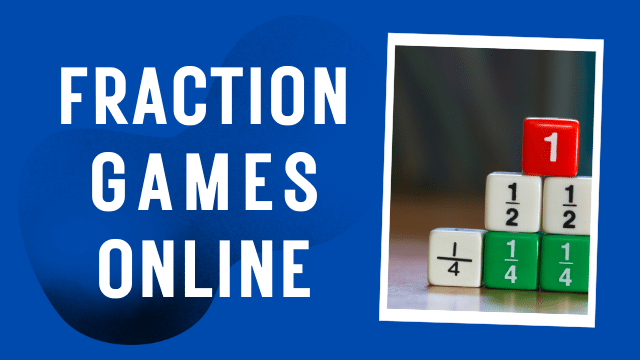.9375 as a Fraction | .9375 as Fraction
In the world of mathematics, numbers can take on various forms and representations. One such representation is a fraction, which is a way of expressing a part of a whole. In this article, we will delve into the world of fractions and explore ".9375" as a fraction. We will break down this decimal number into its fractional form, explaining the concept step by step. So, if you've ever wondered how to express this decimal as a fraction, you've come to the right place. Continue below >>
Fractions with pictures dinosaur game online.
Beat the dinosaurs and arrive home
Online game on fractions shown on pictures.
Addition of fractions crocodile game online
Online board game on adding fractions
Add two fractions while playing with zombies
Zombie game on addition of mixed fractions
Zombie game on fractions with squares
Find the fraction values of numbers
Find the percentage of numbers game
War game online on fractions to decimals.
Online board game on comparison of fractions.
War board game on fractions for kids.
Fraction of a number game online
Wheel of fortune fractions game
Multiplication of two fractions spin the wheel.
Spin the wheel game on fractions of numbers.
Wheel spin convert fractions to decimals.
Fractions shown with pictures backball game
More games: Compare fractions basketball game | Addition of fractions basketball game online | Addition of mixed fractions |

1. Introduction
Fractions are an essential concept in mathematics. They represent a part of a whole and are used in various real-world scenarios. In this article, we will explore the concept of fractions and specifically focus on converting the decimal ".9375" into its fractional form.
2. What is a Fraction?
A fraction is a mathematical expression that represents a part of a whole. It consists of two parts: the numerator (the top number) and the denominator (the bottom number). The numerator tells us how many parts we have, while the denominator represents the total number of equal parts that make up the whole.
3. Decimal to Fraction Conversion
Converting a decimal to a fraction may seem daunting, but it follows a systematic process. Let's break it down into steps:
Step 1: Identify the Decimal
First, identify the decimal you want to convert to a fraction. In our case, it's ".9375."
Step 2: Determine the Place Value
Next, determine the place value of the decimal. This will help us express it as a fraction.
Step 3: Express as a Fraction
Now, we'll use the place value to write the decimal as a fraction.
4. ".9375" as a Fraction
Let's apply the steps mentioned earlier to convert ".9375" into a fraction:
Step 1: Identifying the Decimal
Our decimal is ".9375."
Step 2: Place Value Analysis
- The digit "9" is in the tenths place.
- The digit "3" is in the hundredths place.
- The digit "7" is in the thousandths place.
- The digit "5" is in the ten-thousandths place.
Step 3: Converting to Fraction
To express ".9375" as a fraction, we'll use the place values:
- Tenths: 9/10
- Hundredths: 3/100
- Thousandths: 7/1000
- Ten-thousandths: 5/10000
Now, combine these fractions:
".9375" as a fraction is 9375/10000.
5. Simplifying the Fraction
To simplify the fraction 9375/10000, we can divide both the numerator and the denominator by their greatest common factor, which is 125.
9375 ÷ 125 = 75 10000 ÷ 125 = 80
So, the simplified fraction is 75/80.
6. Why ".9375" as a Fraction Matters
Understanding how to convert decimals into fractions is valuable in various mathematical and real-world contexts. Fractions are used in science, engineering, cooking, and many other fields. Being able to work with fractions enhances your problem-solving skills.
7. Real-World Applications
Fractions are not just theoretical; they have practical uses too. They are commonly used in cooking recipes, construction measurements, and financial calculations. For example, when you need to double a recipe that calls for 3/4 cup of sugar, understanding fractions becomes essential.
8. Common Fractions
".9375" as a fraction, 75/80, may not be the most common fraction you encounter, but understanding the basics of fractions, such as 1/2, 1/4, and 3/4, is fundamental in everyday life.
9. Fraction FAQs
Q1: Can all decimals be converted to fractions? A1: Yes, all finite decimals can be converted to fractions using the method mentioned in this article.
Q2: How do I simplify fractions? A2: To simplify fractions, find their greatest common factor and divide both the numerator and denominator by it.
Q3: What is a mixed number? A3: A mixed number consists of a whole number and a fraction, such as 2 1/2.
Q4: Are fractions used outside of mathematics? A4: Yes, fractions have practical applications in various fields, including cooking, construction, and finance.
Q5: Can fractions represent values smaller than 1? A5: Absolutely, fractions can represent values smaller than 1, such as 1/2, 1/4, and so on.
10. Conclusion
In this article, we explored the concept of fractions and learned how to convert the decimal ".9375" into its fractional form, which is 75/80 when simplified. Understanding fractions is a valuable skill that can be applied in various real-world scenarios, from cooking to engineering. Now that you know how to convert decimals to fractions, you're equipped with another tool to tackle mathematical challenges.
